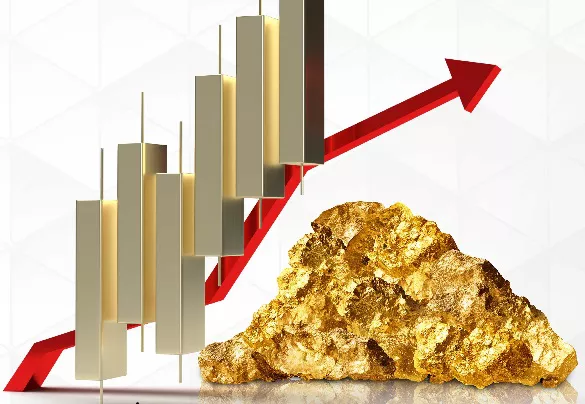Over the past five years, the price of gold has surged by more than 78%. With gold bars weighing around 400 ounces, this has led to each bar now being valued at more than $1 million. The recent catalyst for this surge was the news of President Donald Trump imposing a 25% tariff on steel and aluminum imports.
Before this announcement, fears of resurging inflation had already been driving investors toward gold. While interest rates fell in the UK in February, the Federal Reserve in the US appears to have ended its rate-cutting cycle in an effort to curb rising prices. The potential for a global trade war and concerns over inflation have been adding upward pressure to gold prices. As Faisal Sheikh, managing director at Monmouth Capital, puts it, “Trump’s tariffs, if enacted seriously, are likely to cause inflation, while also increasing uncertainty—both factors drive demand for gold.”
Central banks have also played a role in fueling the demand for gold. Particularly in countries like Russia and China, central banks have been increasing their gold reserves, pushing up the price of the yellow metal. Additionally, gold’s growing use in industries such as nanotechnology, artificial intelligence (AI), cancer therapy, and even malaria treatment has added to its appeal.
Why is Gold Price Rising?
Three key factors have driven the rally in gold prices since 2024: interest rates, central bank purchases, and geopolitical uncertainty.
Interest Rates
History shows that gold prices tend to rise when interest rates fall. Central banks often cut rates in an attempt to stimulate a stagnating economy, which in turn makes gold more attractive since it doesn’t pay interest. Josh Saul, CEO of The Pure Gold Company, explains, “Gold, which pays no interest, becomes more attractive in a low-interest environment.”
The Federal Reserve’s rate-setting decisions have been particularly influential on gold prices. As central banks globally began cutting interest rates in 2024, Western investors flocked back to gold, contributing to the price surge.
Central Bank Purchases
Central banks have been major players in driving up gold prices, especially in emerging markets like China, India, Russia, and Turkey. These countries have increased their gold reserves as a hedge against global economic fragmentation. Anita Wright, an independent financial adviser at Bolton James, points out that these central banks are “dramatically increasing their gold purchases, reflecting growing mistrust in the US dollar.”
In 2024, central bank gold purchases exceeded 1,000 tonnes for the third consecutive year. The World Gold Council expects this trend to continue in 2025, with central banks and gold ETF investors playing a key role in driving further demand.
Geopolitical Uncertainty
Geopolitical uncertainty also plays a significant role in gold’s price rally. As a safe-haven asset, gold tends to attract investors during times of conflict and instability. The ongoing tensions in the Middle East, the persistent war in Ukraine, and the uncertainty surrounding Trump’s trade policies have contributed to gold’s rise.
As Susannah Streeter, head of money and markets at Hargreaves Lansdown, notes, “While the truce is holding in Gaza for now, tensions are still high in the Middle East and the war in Ukraine remains intractable.” Additionally, the volatility caused by Trump’s trade policies has fueled further demand for gold.
Impact of DeepSeek on Gold Price
In late January, the stock market, particularly the tech sector, faced a shock after the Chinese generative AI startup, DeepSeek, claimed that it could outperform OpenAI’s ChatGPT with less than $6 million in investment. Investors fled tech stocks in search of safer assets, contributing to gold’s upward momentum.
Streeter suggests that “the gyrations on stock markets, caused by progress made by Chinese AI rival DeepSeek, which has potentially threatened the dominance of Silicon Valley, may have helped gold’s glittering run upwards.”
Will Gold Continue to Rally?
Predicting gold’s price movements is always challenging, but there are indications that gold’s rally could continue throughout 2025. The market consensus suggests that the Federal Reserve will continue to cut interest rates, with inflation softening but still above target. While the US dollar may remain stable or weaken slightly, global growth is expected to remain positive but below trend.
Goldman Sachs forecasts that gold could surpass $3,000 an ounce by the end of 2025. Similarly, Eric Strand, CEO of AuAg Funds, believes the inflationary pressures will push gold prices above $3,000, with the potential to hit as high as $3,300.
Looking longer-term, experts see $4,000 as a possible target for gold. “Once $3,000 has been breached, we will then have to re-assess,” says one analyst, emphasizing the potential for continued growth.
How to Get Exposure to Gold
There are three main ways to invest in gold:
- Direct investment in the metal itself through exchange-traded products (ETPs).
- Indirect investment by buying shares in gold miners or investing in gold funds or investment trusts.
- Physical gold through purchasing bars or coins.
Investment experts suggest holding around 5-10% of a portfolio in gold, which serves as insurance alongside equities and bonds. However, as with all investments, it’s important to remember that gold prices can go up or down. While gold has historically risen during economic crises, it can also lose value, as seen in the ‘70s and ‘80s.
Streeter advises that gold should only make up a small portion of a diversified portfolio due to its volatility.
Related topics:
What Is The Most Expensive Gold Coin In The World
What Is The Best Options For Investing In Gold

